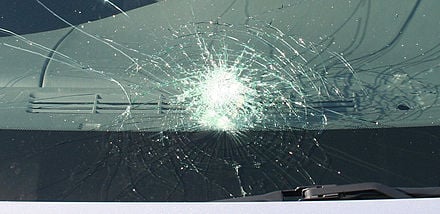Laminated glass
“Sandwich Glass” redirects here. For other uses, see Sandwich Glass (disambiguation).
Automobile windshield with “spider web” cracking typical of laminated safety glass. Laminated glass is a type of safety glass that holds together when shattered. In the event of breaking, it is held in place by an interlayer, typically of polyvinyl butyral (PVB), ethylene-vinyl acetate (EVA), or Thermoplastic Polyurethane (TPU), between its two or more layers of glass. The interlayer keeps the layers of glass bonded even when broken, and its high strength prevents the glass from breaking up into large sharp pieces. This produces a characteristic “spider web” cracking pattern when the impact is not enough to completely pierce the glass. In the case … Continue Reading (7 minute read)